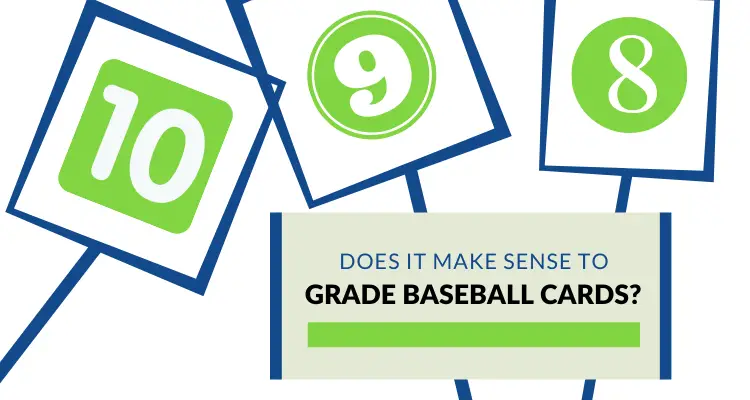 Ryan Barone (@ballcardgenius, Card Expert) is a lifelong member of the hobby. He has been quoted in PSA Magazine, and his content has regularly been mentioned in “Quick Rips” (the Topps RIPPED Newsletter) and across other hobby publications. hello@ballcardgenius.com; Last Time Ago LLC dba Ballcard Genius.
Ryan Barone (@ballcardgenius, Card Expert) is a lifelong member of the hobby. He has been quoted in PSA Magazine, and his content has regularly been mentioned in “Quick Rips” (the Topps RIPPED Newsletter) and across other hobby publications. hello@ballcardgenius.com; Last Time Ago LLC dba Ballcard Genius.
Affiliate Disclosure: This post contains affiliate links. As I am a part of the eBay Partner Network and other programs, if you follow these links and make a purchase, I’ll receive commission. As an Amazon Associate, I earn from qualifying purchases.
Something that I’ve gathered through my own grading and from the many emails I receive from you all is that grading cards is tough. So, to give yourself the best chance at a PSA 10 you need to be realistic about your card’s condition, while meticulously checking the four main condition factors (corners, centering, surface, and edges).
Of course, a gem mint PSA 10 and a PSA 9 may appear similar, and that’s what makes this tough! But as you probably know by now, while a PSA 9 can be a good grade depending on the card, there is a significant difference in value between the two grades (which usually stems from a noticeable blemish on the 9 where the 10 really stands out as “gem mint” and virtually flawless).
Difference in values between a Mike Trout 2011 Topps Update PSA 10 and PSA 9:

As a result, collectors are willing to pay a premium for a card that is in “perfect” condition; it’s a symbol of quality and rarity, and represents the top of card grading mountain. Especially for those who have purchased a raw card or pulled one from a pack and then sent it in for grading themselves, a PSA 10 can be a source of pride.
I’m not going to lie, it’s a great feeling! But for as good as landing your first 10 feels, a 9 (or worse) can be a gut punch if you weren’t expecting it.
Here are some tips on how to give yourself the best chance at getting a PSA 10:
1. Be Realistic
I can’t stress this enough, and it should always be the first step of your grading journey! To give yourself the best chance at obtaining a PSA 10 grade for your card, it is crucial to be realistic about its condition. We are all guilty of this, and it’s common for collectors to have a biased perspective and believe that their card is flawless.
Familiarize yourself with this: PSA defines a PSA 10 as “four perfectly sharp corners, sharp focus, and full original gloss”. This means that the card is virtually flawless with little to no imperfections.

However, wearing blinders and ignoring potential blemishes will not help you achieve the desired grade! Instead, you’ll be left with wasted money and frustration. Trust me, I get it. I’ve had a handful of raw cards come in where I was just itching to get them into a Card Saver, only to see that heartbreaking flaw.
So again, look at your cards objectively. If you see the flaw, a professional grader should see it as well.
2. Go Through a Visual Pre-Grading Checklist ##
To be realistic, though, you need to be thorough, and that includes going through your own pre-grading checklist. At the very least, you need to be checking out through the main condition factors of centering, corners, surface, and edges.
Here is a checklist that might help!
1. Centering
2. Corners
3. Surface
4. Edges
Centering: I personally like to start by examining the centering of a card, as it’s usually the easiest to determine upon first look. A PSA 10 requires at least 60/40 centering, and if you aren’t sure what that means, I encourage you to get familiar with these card centering examples and PSA’s centering standards.
Corners: Next, look to the four corners of your card. PSA 10 cards should have sharp, crisp corners without any signs of wear or damage. Even the slightest imperfection can result in a lower grade. Take your time to inspect each corner carefully under proper lighting. This is one area where it becomes tough to remain realistic—your card might have three amazing/perfect corners, but that fourth matters.
Surface: Next, the surface of the card is another critical factor to consider. PSA 10 cards should have a clean, smooth surface without any scratches, scuffs, or print defects. To help what might be an untrained or biased eye, use a magnifying glass or a loupe to examine the surface closely and identify anything that may affect the grade.
Edges: Last, inspect the edges of your card as PSA 10 cards should have sharp, well-defined edges with no signs of chipping or fraying.
And a big reminder—check the front and the back! While PSA has relaxed centering standards for the back of the card (75/25), you need to check the other areas.
All in all, examine your card under proper lighting and magnification to more easily identify any flaws.
3. Examine the Details
One thing that is easy to overlook is that just because a card came from the manufacturer in a certain way, it doesn’t mean it’s perfect or gradable. And given we have already talked about the basic conditional aspect, I’m now talking mostly about print quality.
PSA 10 cards should have clean, crisp printing with no smudges or fading, and in terms of colors, PSA 10 cards should have vibrant, true-to-life colors. Any discoloration or fading can impact the grade. Even if not visible, the card’s texture should be smooth and consistent.
**One of the biggest debates of print quality is what we call the “print line” that usually shows up on Prizm and refractor cards. This is one “defect” that seems to not impact the likelihood of a card receiving a 10 grade:
FYI,
— Baldy's Sports Cards (@BaldyCards) November 3, 2022
This is a Scope transition line as I like to call it. Call it a print line as well. These do not stop cards from getting a PSA 10. Someone was devastated their card had one I said nah send it. I believe PSA is inconsistent in how they grade these.@PSAcard @natsturner pic.twitter.com/uiBJvdLeAn
PSA 10 Is Never Guaranteed
Last, while it may be disappointing, it’s important to understand that a card that checks all the boxes and appears perfect isn’t guaranteed to earn a PSA 10. Unfortunately, for now, the grading process is subjective, and even if a card looks flawless, it may not receive the grade it deserves.
With grading being a manual process, there can be differences in opinion among graders, and what one grader may consider a PSA 10, another may see as a PSA 9. It’s just like the umpire on the baseball diamond—a strike is a strike until it’s called a ball.
It’s also worth noting that PSA graders have to assess a large number of cards each day, which can lead to inconsistencies in grading. Bottom line—human error is inevitable.



